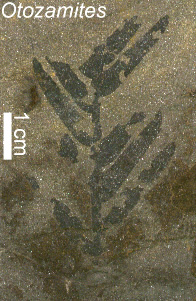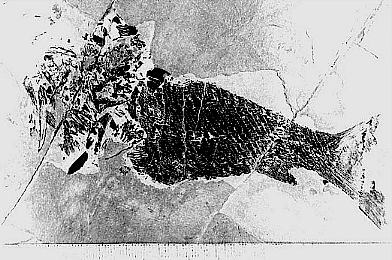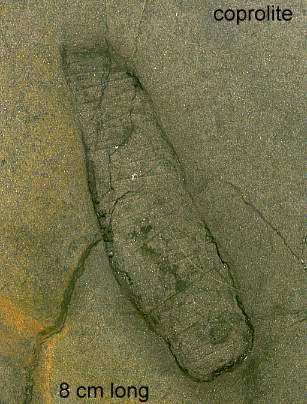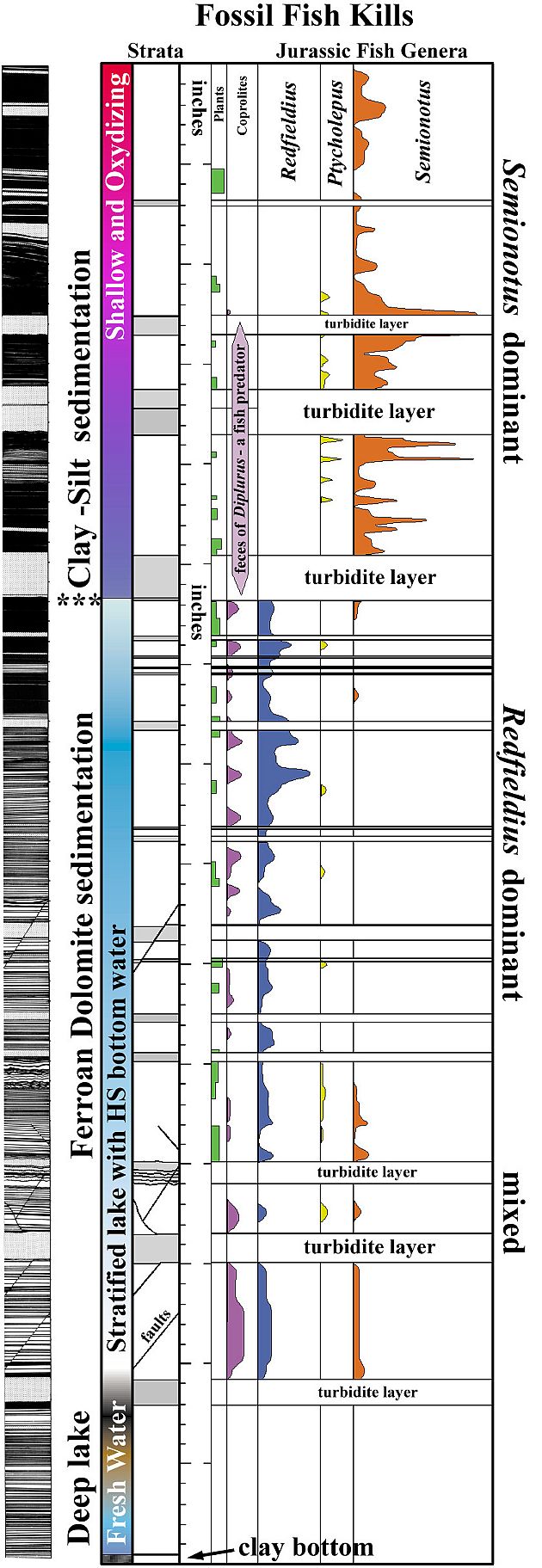Results of Data Analysis
Count totals for fish, Diplurus coprolites, and plant remains from first excavation area (6 feet long by 3 feet wide) at Bluff Head locatity on eastern side of Totoket Mt., North Guilford, CT, U.S.A.
 |
The fish population in this Early Jurassic (200 million year old) lake
deposit changed significantly twice during the lake's history, producing three distinct
types of fish assemblages. That change in fauna is documented by the composition of fish
in fish-kill layers, as well as by the changes in sedimentary mineralogy, chemistry, and
structure. These changes can be attributed to shifts in lake water chemistry, as well as
to the depth of the lake. We can put size constraints on the size of the lake through the
study of rock structure along the southeastern part of the Hartford basin half-graben. A
mechanism for the creation of a deep lake along the main fault-bounded side of the
half-graben was mapped by Sanders et al., 1963 (Foxon fault and Gaillard graben in the
Triassic of southern Connecticut, State Geol. Nat. Hist. Surv. of Conn., report no. 2).
The Gaillard graben was probably responsible for creating a deep depression that formed
the lake, and controlled its water depth. Turbidite silt layers are either absent or very thin above unit 3B1, indicating that sediment stability along the lake margins had increased, perhaps due to greater fresh water influx and more mixing of sediment grain size during upland runoffs during heavy downpours.
One rare Diplurus coprolite.
Lake sedimentation and water chemistry began to change radically as carbonate deposition decreased between stratigraphic units 11AB and 10AB. Clay and silt content increased, causing strata to become less microlaminated or more massive (dark). The large turbidite silt layer at unit 8AB1 represents a significant evolutionary event in the history of the lake. Following that event Redfieldiids no longer existed in the lake. Subsequent fish-layers contain no trace of Redfieldiids, even though the numbers of dead fish per unit volume of sediment shows a significant increase. The decline in numbers of Redfieldiids in unit 8AB might be due to a combination of smaller size of the Redfieldiid population and the severity of killing events, because juvenile fish appear for the first time.
Something changed in the lake chemistry which excluded Semionotids, but favored Redfieldiids and Ptycholepids. The predator Diplurus, which was capable of breathing air, could survive toxic events in the lake. The appearance of ferroan dolomite and decrease in calcite might indicate an increase in lake water PH.
All fish genera are represented in the lake during its early history, which tells us that lake chemistry was different (less extreme) from that when either Redfieldiids dominated the fish population or Semionotids dominated the population.
Fish kills indicate that meromictic lake stratification had begun. A denser H2S-rich bottom layer formed due to the probable development of anaerobic, organic-matter bacterial biogenesis in the bottom muds. H2S is extremely toxic to aerobic life forms. It is a byproduct of anaerobic biogenesis.
No fish kills recorded, implying that an extensive anaerobic bottom layer had not yet evolved. There was no anoxic H2S bottom layer shallow enough to cause fish kills (due to storm mixing with the aerobic top freshwater layer where the fish lived). |
Because the Gaillard graben lake became meromictic, or vertically stratified into different chemical layers, it had a large community of organisms living in an aerobic freshwater top layer (epilimnion). That community included abundant algae (algal reefs developed along the southwestern margin of the lake) and many different types of fishes. Carbonate deposition seems to have occurred seasonally, because sedimentation alternated between thin layers of carbonate or micrite and thin layers of organic-rich clay (forming couplets called varves). Most of the organic content is comprised of algal debris. Deeper in the lake an anaerobic bottom layer existed (hypolimnion); it contained iron and sulfur bacteria which slowly decomposed dead algae falling from above to produce Hydrogen Sulfide (H2S) gas, which is soluble in water. Carbon dioxide levels may also have built up in the hypolimnion due to anaerobic activity, adding to a lethal gas content. Because of thermal and chemical stratification, the two layers (epilimnion and hypolimnion) did not mix, except when disturbed by wind fetch (wave energy) during severe storms and by freshwater runoff from the adjacent highlands. When the layers mixed, a fish kill occurred due to H2S and CO2 poisoning.
Plant remains would also be washed or blown into the lake at this time. The most common type of plant fossil found in the lake deposits was Otozamites sp., a Cycadophyte.

During severe storms the bottom layer was disturbed and some of the toxic H2S would get into the top layer containing thousands of fishes. Hydrogen Sulfide is one of the most toxic gases on Earth (toxic to aerobic life). It is more toxic than Hydrogen Cyanide gas, but because of its foul rotten-egg odor, it can be detected easily by humans. During storms those mixing episodes caused many fish to die. Their remains sank to the bottom of the lake, where they were preserved. The dead fish did not rise to the surface, because H2S poisons aerobic bacteria, and bloating from rapid decomposition under aerobic conditions did not occur. Consequently, most of the fish did not rise to the top of the lake as is typical in oligomictic lakes, which do not have a large anaerobic bottom layer. The periodic removal of oxygen in portions of the top layer contributed to the excellent preservation of tens of thousands of fishes. Some evidence of aerobic decomposition was found, where a portion of a fossil fish was destroyed by expanding gases. A specimen of Ptycholepis below shows its head damaged by aerobic decomposition before it sank to the lake bottom, where further anaerobic decomposition caused the scattering of its bones and scales.

Predatory Fish
A large predatory fish lived in the lake. Evidence of its presence is indicated by all the coprolites it left behind (from the digestion of other fish). That evidence is given below in a graph. One specimen of a large ceolocanth (Diplurus) was found in the two excavated areas. The specimen was complete, and measured about two feet in length. It also had a black coprolite in its abdominal area, which made it the number one suspect as the predator. The graph below shows a correlation between peaks and valleys in curves for coprolites and Redfieldiids, implying a relationship (not a very nice one). We know that the black, oblong to elliptical masses are coprolites, because a chemical analysis demonstrated that they are comprised of bone and organic residue.
Volatile organic matter: 13.8% Insoluble residue (clay): 6.4% Iron pyrite (FeS2): 10.4% Calcium phosphate (CaHPO4): 69.4% |

Alternative Graph Showing Data as Fluctuations

Copyright B. Cornet 1999